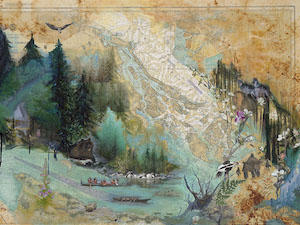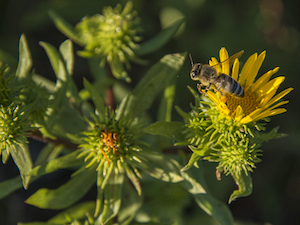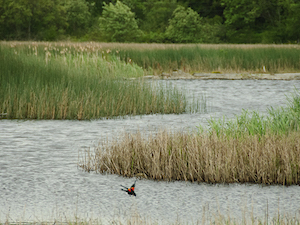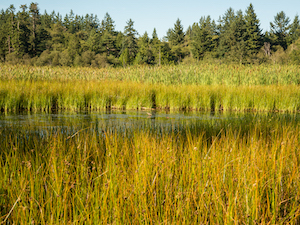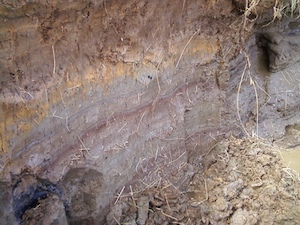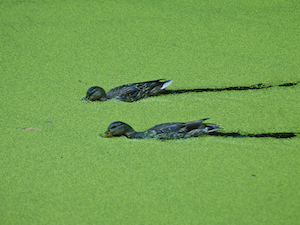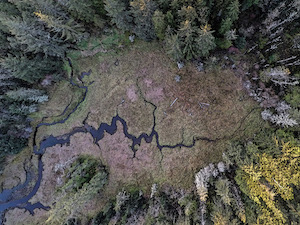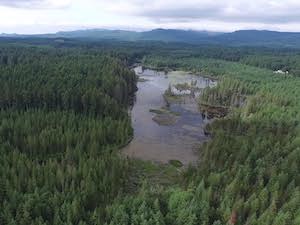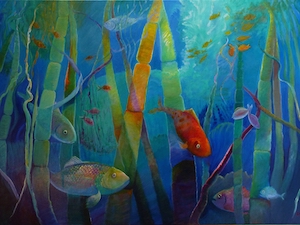NEWTS: WETLAND MAGICIANS
by Sharon & Paul Pegany, Autumn 2020
Photos by Sharon Pegany except as noted
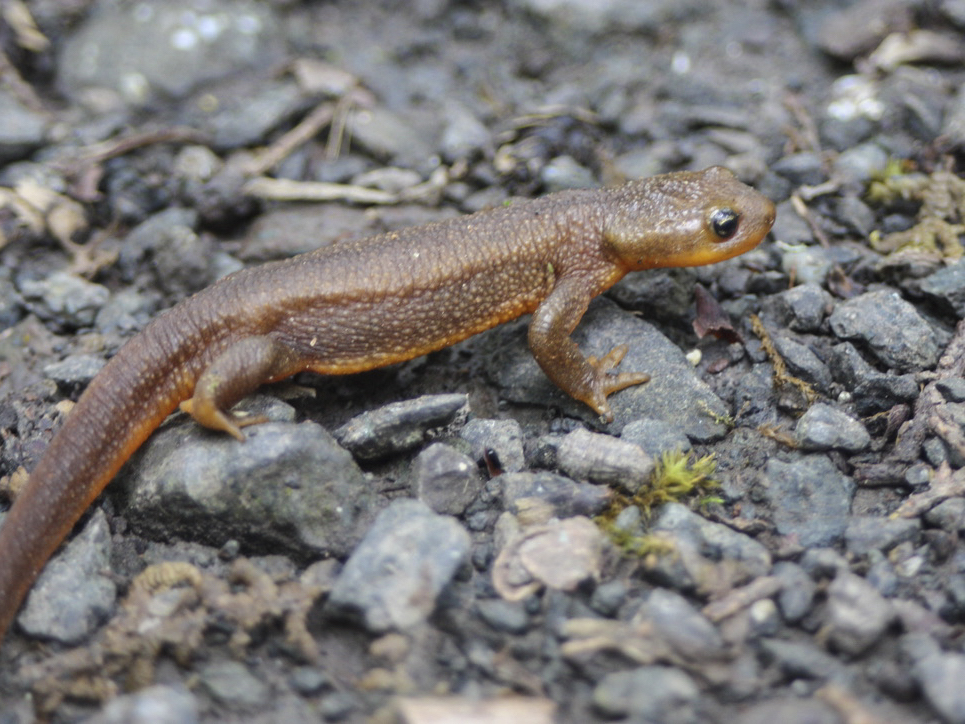
NEWTS: WETLAND MAGICIANS
by Sharon & Paul Pegany, Summer 2020
Photos by Sharon Pegany, except as noted.
Did I just see what I think I saw? I had to do a double take while exploring the edge of a local pond this past spring. Was I really watching a bunch of lizards swimming underwater like a school of fish? With classic dog paddle strokes and agile rudder-like tails, they seemed totally at home among the lily pads and dragonflies. Upon closer inspection, I recognized the unmistakable color and shape of our own native rough-skinned newt primarily seen moseying along the forest floor. What had bewitched these little creatures, causing them to suddenly go for a springtime swim?
Here in the Salish Sea region, we have our share of creatures who make their homes in or around wetlands, from a variety of frogs and toads to insects, snakes and mammals, but there is only one newt. The Pacific newt, also known as the western or rough-skinned newt, is commonly found in coastal areas from Santa Cruz, California to Alaska.
what on earth is a newt and is it different from a salamander?
Let’s start with a few basics. All newts are salamanders — but not all salamanders are newts. Despite sounding like an analogy question from a college entrance exam, the phrase does point to the fact that “salamander” is the name we give to the large group of amphibians that have tails as adults. Newts are simply one type of salamander in the same way mice are one type of rodent.
Several species of salamanders are commonly found throughout western Washington wetlands and each have their own identifying characteristics. Rough-skinned newts can be easily identified by their granular skin versus the smooth skin of most other salamanders. This newt ranges in color from dark gray to reddish-brown. As adults, most spend considerable time in moist terrestrial habitats, always returning to the water come mating time, which can range from December through June, depending on location and temperature. Near our home in Kitsap County, we often see large groups of them in ponds during the months of April and May.
newt field notes
- Newts have four legs and resemble a cross between a frog and a lizard.
- While most types of salamanders have smooth, moist skin, rough-skinned newts have dry, warty, reddish-brown skin.
- Newts begin life in the water, but live the remainder of their lives in and out of the water. The amount of time in/out of the water can vary is the subject of debate.
- Newts tend to have flatter, paddle-like tails when compared to other types of salamanders.
- Salamanders can range from just over an inch to over a foot. One Asian variety grows to over three feet in length! Newts are smaller salamanders, typically ranging in size up to about eight inches.
- Newts exhibit more elaborate courtship rituals than most other types of salamanders and there are more differences between sexes.
hands off newts
If you spot a rough-skinned newt on a trail, it is advisable to keep your hands off! Newts may be small, but they make sure to get the last laugh if disturbed. Often, a newt’s first response to potential danger is to dramatically arch its back, exposing a brightly colored underside. Typically, that is enough to send would-be predators scurrying away.
The newt’s skin also produces a powerful neurotoxin called tetrodotoxin, which is the most toxic non-protein substance known. This toxin interferes with nerve cells, preventing them from firing correctly and can lead to paralysis and death in creatures unfortunate enough to ingest even a part of the deadly skin. Some studies have indicated that the toxin in a single newt is potent enough to kill up to 25,000 mice! Interestingly, the common garter snake seems to have varying degrees of immunity to the newt’s toxin and is its major predator. While its effects are typically only severe when the newt is ingested, humans have reported skin irritation after even touching rough-skinned newts.
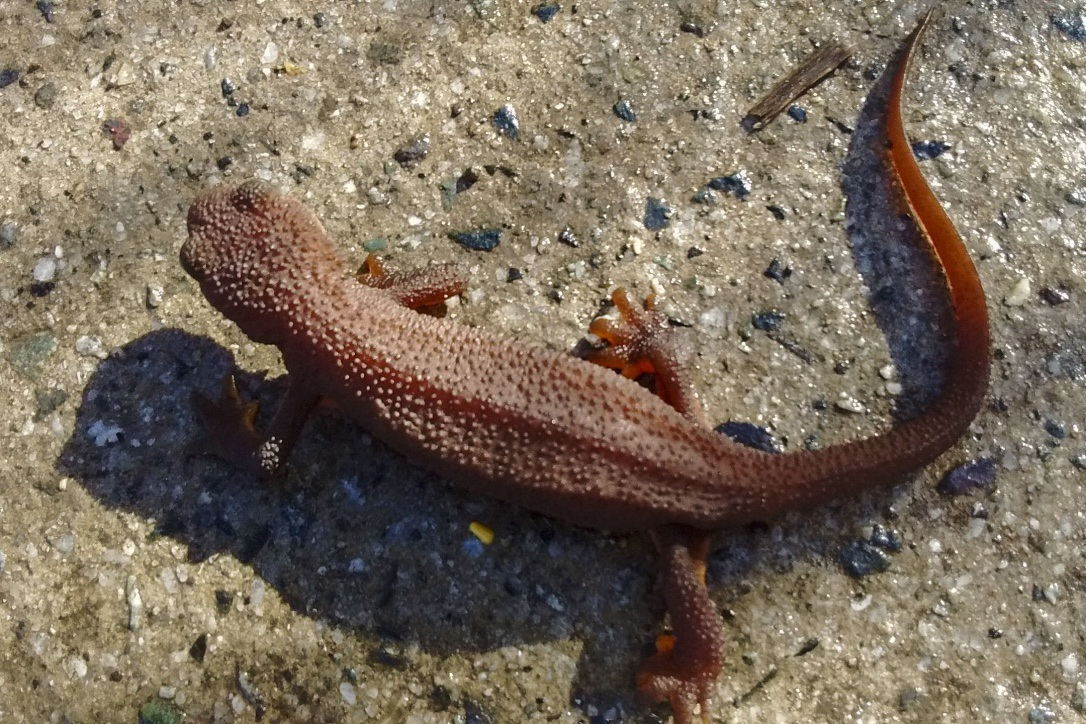
regeneration magicians
As a kid, I loved to watch the TV series Bewitched. When incantations were recited, their verbiage was always sure to include “eye of newt.” Perhaps there was something to using the newt in a spell, as they seem to demonstrate an almost magical ability to regenerate their eyes, as well as many other parts of their bodies. Who knew I was learning biology while watching Bewitched?
The fact is, newts, along with several other salamanders, are masters of regeneration. There is no other group of animals that can match their regenerative abilities. Depending on the species, they are able to regenerate their legs, tail and spinal cord, brain, heart, jaws, and eyes.
So, how do they pull off their regenerative magic? Imagine that a newt loses a leg to a predator. A mass of cells, called a blastema, is generated at the stump. From that blastema, the cells for bone, blood vessels, nerves, and muscle will begin to grow. The regeneration process takes many weeks. The new limb might not be an exact duplicate of the original, but it will still be fully functional. While mammals, including humans, might not ever have this incredible regenerative ability, scientists continue to study the process, hoping to better understand wound healing and repair. These little wetland magicians may hold the keys for some astounding medical breakthroughs in the future.
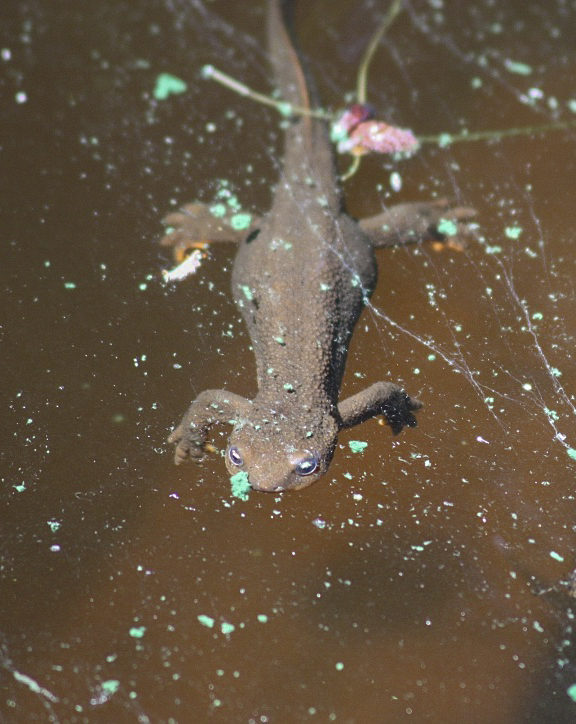
salamanders are essential workers
All salamanders are essential to western Washington wetlands. First, they are an integral part of the food web. The toxicity of some salamanders, such as the rough-skinned newt, make them risky meals for predators, but some species of fish dine on salamander eggs and larvae. Salamanders are not fast movers themselves, so they prey on slower moving creatures of the wetland — small crustaceans, insects including mosquitoes, and spiders among others.
Secondly, like all amphibians, salamanders are wetland essentials in that they provide a wide window into the health of the surrounding environment. The thin, moist, highly absorbent skin of amphibians is very sensitive to chemical changes, making them among the first animals to signal a wetland in ill-health. Like salmon and other iconic species, salamanders need cold, clean water to survive. Salamanders prefer to lay their eggs when the water temperature is slightly above freezing, so even small changes in temperature and turbidity impact their ability to successfully find shelter, hiding, and nesting sites in which to reproduce.
mystery solved
So why were rough-skinned newts swimming in the pond on a spring afternoon? Probably for the same reason most animals do strange things. It’s mating season and newts have made their way back to the same breeding pond they always do year after year. Males are on the lookout for females and when one makes an appearance, groups of males swarm her, creating an underwater blob of writhing newts the size of a softball. The winning male climbs on the female’s back and cradles her for several hours, afterwhich she follows him along the bottom of the pond, picking up sperm laden jelly packets.
Aside from mating time, coming across a rough-skinned newt is somewhat serendipitous, as they typically come out only at night to hunt. During the warm days of summer and early fall, they spend their days sheltering in dark, moist, places hiding from predators and the sun. If you are fortunate enough to spot one during the day, seize the moment as they are typically not overly skittish and will generally allow humans the opportunity to marvel at their unique features. These tiny wonders puzzle us, instruct us, and delight us with their versatility and beauty. It is impossible to imagine wetlands without them.
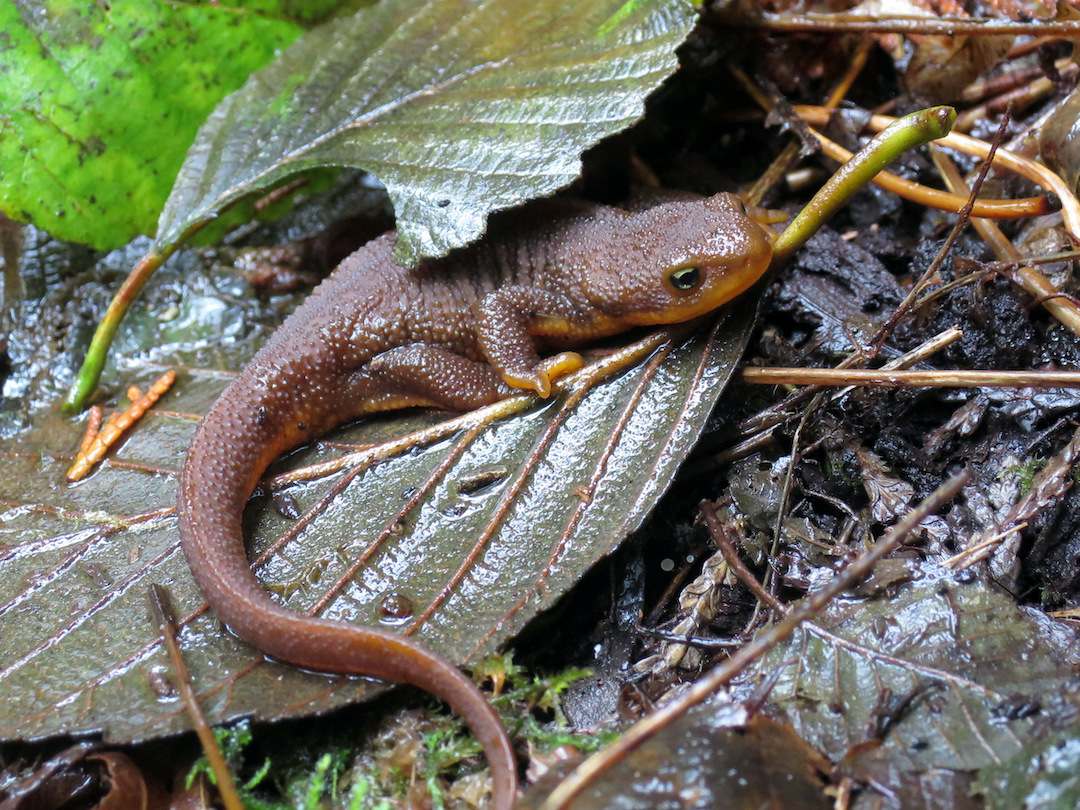
Stock photo
a pandemic of their own
As the world grapples with the human fallout of the Covid-19 crisis, it is easy to forget that animal populations also encounter deadly pathogens that can spread stealthily through their ranks. One example is the fungus batrachochytrium dendrobatidis which has caused severe decline or extinction of more than 200 species of amphibians world-wide over the past 30 years.
Another similar fungus known as Bsal (Batrachochytrium Salamandrivorans) is a fungal pathogen that has decimated salamander populations in northern Europe.
The Bsal pathogen is believed to have originated in Asia, then migrated to Europe in recent years through the pet trade. As this pathogen has escaped into wild salamander populations, it has nearly wiped out various species.
Bsal fungus survives by finding a home on the moist skin of a host salamander. The fungus then multiplies rapidly, causing lesions resembling cigarette burns on its host. Remember, a salamander’s skin is more than just a covering. It is a permeable membrane used for respiration and nutrient absorption. As the fungus creates new populations and lesions on the host, the salamander is unable to properly breath or absorb water and nutrients, so it eventually dies.
One unique feature of this fungus is its ability to live on the surface of water for extended periods of time. As such, a salamander simply has to return to the water for the fungus to find its unwitting host. Additionally, aquatic birds can aid its spread by carrying the fungus on their feet to their next destination.
Fungal pathogens, of course, are nothing new. For eons, amphibians have developed responses to various challenges of the watery world surrounding them. But, over the past one hundred years, humans have rapidly altered the chemical composition of our planet’s waterways as we constantly inundate them with new biologically active chemicals for farming, medical waste, and other accoutrements of modern living. The speed of this environmental altering has surpassed and overwhelmed the ability of amphibians to develop appropriate immune responses, leaving them more vulnerable to naturally occurring fungal pathogens, such as Bsal.
The United States is home to about one-third of the world’s species of salamanders, many of which are considered particularly vulnerable to Bsal. While many of these species live in the American southeast, Salish Sea area salamanders, including our rough skinned newt, have also demonstrated lethal vulnerabilities.
So, as stewards of our planet, what can we do to help all wildlife and salamanders in particular? For starters, educate yourself and others as to the wide-reaching ripple effect of our own choices and behaviors. Remember that clean water is the greatest gift we can give all living things, but especially those who live in water. Our choices regarding chemical use and disposal directly impacts salamander health and reproduction. Clean water may also provide them with the most conducive environment in which to develop immunities to pathogenic challenges.
We can work to achieve this goal by limiting use of pesticides, herbicides, and any chemical soil amendments, particularly in areas near wetlands. Any dumping of human-produced chemicals near waterways has the potential to negatively impact the survival of these creatures. Keep this in mind when using and disposing of chemical and medical products.
In addition, help limit the exposure of salamanders to pathogens outside their native environments by not purchasing salamanders via the pet trade. In 2016, the U.S. Government placed a temporary ban on the importation of salamanders. Make your voice heard by supporting the extension of such legislation should it come up for review.
Together, we can work to ensure the long-term survival of these intriguing wetland creatures and also give us opportunities to understand their amazing abilities.

Sharon Pegany is an educator and citizen scientist who loves to indulge her insatiable curiosity for the natural world. After teaching inside elementary classrooms for over 30 years, she now spends her days outside exploring, learning and encouraging others to wonder about sky, sea, and land through shared hikes, writing, photography and art. Wander with her through the contrasting naturescapes of desert, ocean and forest at pacificwondertracker.com
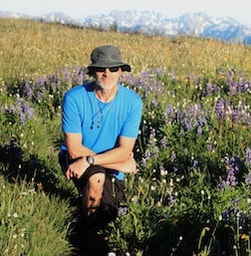
Paul Pegany is a retired elementary educator who has over 30 years of experience in helping students better understand the world around them through science and literature. He splits his time between the Sonoran Desert of Arizona and the forests and seas of the Pacific Northwest. His goal is to help people of all ages better appreciate the beauty of the world, as well as understand the stewardship role that humans play as part of the greater ecosystem. Along with his wife, Sharon, he works to build his own knowledge through coursework and experiences in whichever biome he finds himself.
Table of Contents, Issue #9, Autumn 2020
From Swamps and Bogs …
by Sara & Thomas Noland, Autumn 2020 Photos by Thomas Noland except as notedby Sara & Thomas Noland, Summer 2020 Photos by Thomas Noland except as notedWetlands are part of our landscape here in the lowlands near the Salish Sea. Anyone who’s walked around in a...
Issue 9 Art Poetry
Autumn 2020Juan de Fuca painting by Melissa McCannaJuan de Fuca painting by Melissa McCannaSummer 2020Going Home, painting by Julia MillerComing Home by Dawn Henthorn Salmon come home home to the Elwha. Bit by bit of rubble two feet at a time, the dams were removed,...
Salt Marshes
by Ron Hirschi, Autumn 2020Gumweed photo by John F. WilliamsGumweed photo by John F. Williamsby Ron Hirschi, Autumn 2020I’ve enjoyed, studied, mapped, and tried to protect wet places for pretty much my entire life. So, I thought I’d take the opportunity to share some...
Importance of Wetlands
by Josh Wozniak, Autumn 2020 Photographs by John F. Williamsby Josh Wozniak, Summer 2020 Photographs by John F. WilliamsTaking many forms, wetlands are natural features of the landscape that provide crucial functions for both nature and humankind. We benefit directly...
Healthy Wetlands
by Curt Hart and Marcus Humberg, Autumn 2020Wetland at Point No Point, photo by John F. WilliamsWetland at Point No Point, photo by John F. Williamsby Curt Hart and Marcus Humberg, Summer 2020For the 4.2 million residents in and around Puget Sound, there is a good...
Earthquakes and Tsunamis
by Carrie Garrison-Laney and Ian Miller Autumn 2020 A photo of sediments in the coastal marsh near the mouth of Salt Creek on the Strait of Juan de Fuca, showing distinct bands of different colors and textures. Photo by Ian Miller.A photo of sediments in the coastal...
10 Things About Duckweed
by Adelia Ritchie, Autumn 2020 Photos by John F. Williams, except as notedby Adelia Ritchie, Summer 2020 Photos by John F. Williams, except as noted1. Duckweed grows in dense colonies in quiet water that is undisturbed by wave action. We try to avoid insulting still...
Carpenter Creek Salt Marsh
by Melissa Fleming & Terry Pereida, Autumn 2020 Photos by Terry Pereida, except as notedSalt marsh with the main channel running down the middle. Photo by Tom TwiggSalt marsh with the main channel running down the middle. Photo by Tom Twiggby Melissa Fleming &...
Wetland Basics
Frank Stricklin, Autumn 2020 Photos by John F. Williams except as notedThis large wetland in Newberry Hill Heritage Park is listed by the State of Washington as a “wetland of significant conservation value.” It contains many species of aquatic plants, and some...
Blue Carbon
by Adelia Ritchie, Autumn 2020Underwater Rainbow, painting by Julia MillerUnderwater Rainbow, painting by Julia Millerby Adelia Ritchie, Summer 2020As you’ll see everywhere else in this issue, a wetland system isn’t just another lovely place for a nature walk. Wetland...
PLEASE HELP SUPPORT
SALISH MAGAZINE
DONATE
Salish Magazine contains no advertising and is free. Your donation is one big way you can help us inspire people with stories about things that they can see outdoors in our Salish Sea region.
We also don't advertise Salish Magazine, so please spread the word of this online resource to your friends and colleagues.
Thanks so much for your interest and your support.
We also don't advertise Salish Magazine, so please spread the word of this online resource to your friends and colleagues.
Thanks so much for your interest and your support.



